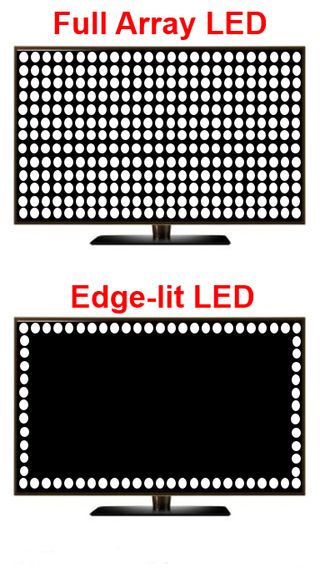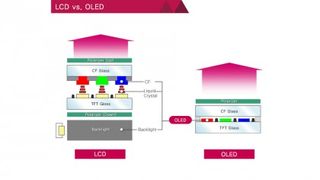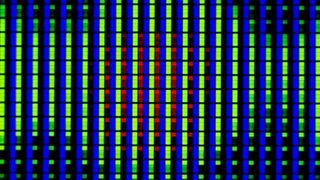What you need to know about TVs and monitors before you buy
LED, IPS, OLED: The panels may be flat, but there's a lot going on in these dense layers
It was just a couple years ago that television manufacturers started selling LCD TVs alongside LED TVs, leading to complete and utter confusion for everyone involved.
Technically, LED TVs are LCD TVs, but they use an improved light source compared to older flat panel televisions. Older LCD TVs relied on cold cathode fluorescent lamps (CCLFs), which operate based on two phenomena: electron discharge and fluorescence, while LEDs use - you guessed it - light-emitting diodes.
Don't freak out. While the technology sounds like something only Tesla himself could understand, it's quite accessible once you wrap your head around it.
Shedding a light on LED
Ask any tech lover worth their weight in silicon and they'll tell you that LED stands for light-emitting diodes, which are smaller and more energy efficient than CCFLs.
LED TV's most marketable feature has been improved backlighting, but the picture quality remains unchanged compared to CCFL-based LCD televisions. Even though LED TVs have gotten less expensive over the years, home theater stores have been using the LED term more often than LCD, as it leaves buyers feeling like they're getting a newer product.
LED backlight technology functions under one of three configurations:

Full Array: A high-end configuration of LED, full array panels distribute the diodes evenly across the screen. Having this uniform backlight allows for more accurate local dimming, where changes in luminosity only occur in a specific part of the screen.
Get daily insight, inspiration and deals in your inbox
Get the hottest deals available in your inbox plus news, reviews, opinion, analysis and more from the TechRadar team.
Edge Lit: Instead of placing diodes throughout the screen, edge lit panels have bulbs along its outside edges. While this version is cheaper to produce than Full Array, the unbalanced configuration often results in an uneven spread of brightness, where the edges are brighter than the rest of the screen.
Direct Lit: Direct lit screens function a lot like a budget version of Full Array. Direct Lit has a spread of diodes across the screen, but uses much fewer LEDs than Full Array. Moreover, these lights cannot be controlled separately to match a given picture's luminosity.
Devices you find it in: The television market is currently dominated by LED with Sony, Panasonic, Samsung, LG and others all producing TVs with the tech. Some retailers are better than others in denoting whether a given TV features Full Array, Edge Lit or Direct Lit lighting, so be sure to do some research before buying.
LED vs OLED
Keeping in mind that LED is essentially souped-up LCD, LED panels have gone one step further in the race for screen supremacy by trading out the filament in the bulb for a brighter, better organic substance in a technology called OLED.
OLED technology is impressive in that it allows for ultra-thin, high-performance monitors. How does it do it? OLED accomplishes this with a six-layer design structure comprised of protective glass or plastic on both sides, positive and negative terminals, and a pair of layers of organic molecules in the middle.
The layer with the organic molecules' interaction with the cathode are what produce the light, while color is created using filters beneath either the top or bottom layer in conjunction with photons. Combined with thousands of red, blue and green OLEDs, these diodes work similarly to LCDs as each color is switched on and off independently.

Due to its thinner display, improved color reproduction, and greater brightness, OLED is often considered a step up over LCD technology. It would be adopted more widely if not for its current shortcomings, which include degradation of the organic molecules, sensitivity to water and steep price tag.
How you can explain it to mom: It isn't perfect, but OLED panels are the best of the best right now. Each pixel is individually lit and therefore has impossible-to-see levels of contrast.
Devices you find it in: High-end televisions including curved TVs and 4K TVs like the LG 65EC9700 and Samsung's S9C series.
There's also AMOLED, which stands for "active-matrix organic light-emitting diode." It's a modified version of OLED where semiconducting film is added behind the panel. The result is a quicker response time for each pixel.
AMOLED screens also benefit from a superb color spectrum as well as great contrast, which is why this technology is primarily used in smartphones and tablets. Their wide viewing angles also make them suited for curved handsets, like the Samsung Galaxy S6 Edge.
How you can explain it to mom: Whereas the pixels in OLED react to a single power source, each pixel in an AMOLED display has its own individual power source.
Devices you find it in: Media players, smartphones, and digital cameras. You won't find AMOLED in TVs or monitors, but since it's a variation of OLED we determined it warranted inclusion in this explainer.

Understanding plasma before it goes extinct
Plasma is created when electrons are generated in gas as a result of high heat. For the purposes of TVs and monitors, plasma is contained in glass spheres as filtered light passes through them from microscopic lamps.
This results in excellent black levels, one of the reasons why plasma has its share of enthusiasts, but risks of image burn-in and high energy consumption limited plasma's wider adoption. Furthermore, OLED has since outmatched plasma in terms of black levels, contrast ratio and color accuracy. Given that manufacturers have ceased production of plasma televisions, 2015 will most likely be the last year you can find plasma TVs in major retailers.
How you can explain it to mom: In high heat, gas gives off electrons. Electrons light up microscopic bulbs of red, blue and green pixels and we see an ultra sharp picture.
Devices you find it in: A very select number of Samsung and LG televisions. Don't expect new plasma TV models in 2016.
If you're interested in learning more about the future of resolutions, check out our 4K and UHD primer. This screen tech is still some time away from going mainstream thanks to its extremely high price points, but we will see more and more 4K-and-beyond screen tech in the years to come.
Most Popular
